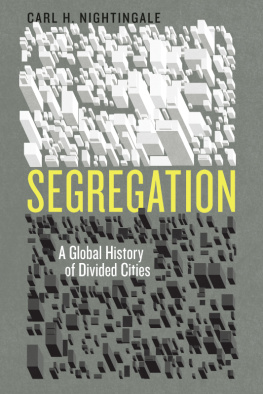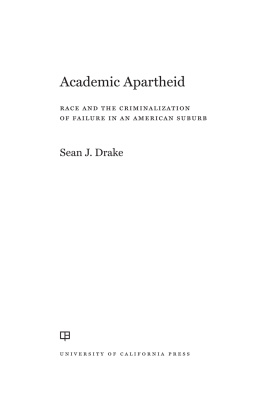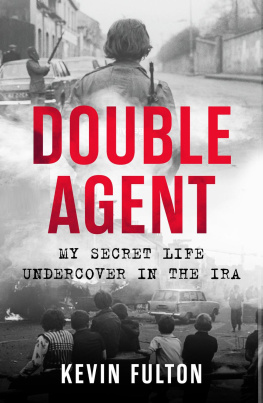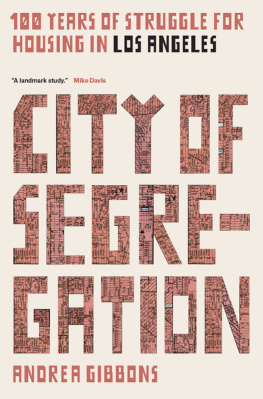HISTORICAL STUDIES OF URBAN AMERICA
Edited by Timothy J. Gilfoyle, James R. Grossman, and Becky M. Nicolaides
ALSO IN THE SERIES:
The Transatlantic Collapse of Urban Renewal: Postwar Urbanism from New York to Berlin
by Christopher Klemek
Ive Got to Make My Livin: Black Womens Sex Work in Turn-of-the-Century Chicago
by Cynthia M. Blair
Puerto Rican Citizen: History and Political Identity in Twentieth-Century New York City
by Lorrin Thomas
Staying Italian: Urban Change and Ethnic Life in Postwar Toronto and Philadelphia
by Jordan Stanger-Ross
New York Undercover: Private Surveillance in the Progressive Era
by Jennifer Fronc
African American Urban History since World War II
edited by Kenneth L. Kusmer and Joe W. Trotter
Blueprint for Disaster: The Unraveling of Chicago Public Housing
by D. Bradford Hunt
Alien Neighbors, Foreign Friends: Asian Americans, Housing, and the Transformation of Urban California
by Charlotte Brooks
The Problem of Jobs: Liberalism, Race, and Deindustrialization in Philadelphia
by Guian A. McKee
Chicago Made: Factory Networks in the Industrial Metropolis
by Robert Lewis
The Flash Press: Sporting Male Weeklies in 1840s New York
by Patricia Cline Cohen, Timothy J. Gilfoyle, and Helen Lefkowitz Horowitz in association with the American Antiquarian Society
Slumming: Sexual and Racial Encounters in American Nightlife, 18851940
by Chad Heap
Additional series titles follow index.
A Global History of Divided Cities
SEGREGATION
Carl H. Nightingale
The University of Chicago Press
Chicago and London
Carl H. Nightingale is associate professor of urban and world history in the Department of Transnational Studies at the University at Buffalo, State University of New York. He is the author of On the Edge: Poor Black Children and Their American Dreams.
The University of Chicago Press, Chicago 60637
The University of Chicago Press, Ltd., London
2012 by Carl H. Nightingale
All rights reserved. Published 2012.
Printed in the United States of America
21 20 19 18 17 16 15 14 13 12 12 3 4 5
ISBN-13: 978-0-226-58074-6 (cloth)
ISBN-10: 0-226-58074-1 (cloth)
ISBN-13: 978-0-226-58077-7 (e-book)
Library of Congress Cataloging-in-Publication Data
Nightingale, Carl Husemoller.
Segregation : a global history of divided cities / Carl H. Nightingale.
pages ; cm. (Historical studies of urban America)
Includes bibliographical references and index.
ISBN 978-0-226-58074-6 (cloth : alkaline paper) ISBN 0-226-58074-1 (cloth : alkaline paper) 1. Discrimination in housingHistory. 2. SegregationHistory.3. Urban policyHistory.4. MinoritiesHousingHistory. 5. Discrimination in housingUnited States. 6. SegregationUnited States.7. Urban policyUnited States.8. MinoritiesHousingUnited States. I. Title. II. Series: Historical studies of urban America.
HD7288.75.N54 2012
305.80091732dc23
2011050362
 This paper meets the requirements of ansi/niso z39.48-1992 (Permanence of Paper).
This paper meets the requirements of ansi/niso z39.48-1992 (Permanence of Paper).
to Mbali, Martha, Skhumbuzo, and our tricontinental extended family of relatives and friends
for your loving reach across long distances and urban color lines
Contents
Acknowledgments
This book tells a story about powerful institutions and intellectual networks and how they spread coercive practices of residential segregation to cities around the world. The book came into being, however, because of a very different sort of intellectual network, one that reached across both color lines and long distances and that was powered by the generous support of dozens of institutions, hundreds of suggestions for improvements, and thousands of individual acts of collegiality, kindness, political courage, faith-building, and friendship.
Within that beneficent community, there are a few people who have given this book close scholarly attention from its earliest inception to its finish. Martha T. McCluskey shared seventeen years of conversations with me exploring the relationship of ideas, politics, law, and institutions. These, combined with inspiration from her own wide-ranging work on legal theory and economic justice, infuse all aspects of the books conceptual architecture. As a graduate student long ago, I was lucky to have Daniel T. Rodgers as an advisor. Since then, he has become a lifelong academic councilor and voracious reader of pages I send him. He scoured the manuscript, both in portions and in its entirety, several times along the way, refreshing it with his own deep experience of writing border-crossing history. On the repeated occasions that I hunted Michael B. Katz and Mike Frisch down in their adjoining cabins in Maines western woods, they took time from their own academic pursuits to encourage this project and push it toward more productive aims. Since meeting Thomas Bender at his pathbreaking conference on global approaches to American history, he has relentlessly encouraged my travel beyond the geographical boundaries of my professional training. Paul Kramer has been willing on multiple occasions to repeat the founding event of our friendship, a casual encounter in St. Louis that turned into a five-hour conversation on empires and other macrohistorical subjects. I was similarly lucky to encounter Aims McGuinness, this time in Milwaukee, also a granter of enormous amounts of conversation time. Among many other things, I am grateful for his deep understanding that very big historical things are made up of the very smallest things. Thanks too for his thoughts on his students reactions to various drafts of the work. Throughout the writing of this book, I have also benefitted from a half dozen long conversations with Robert O. Self, this time on entanglements between urban, national, and international politics. My Buffalo colleague Theresa Runstedtler has been another great source of inspiration, especially on questions of race and turn-of-the-twentieth-century global popular culture. The results of her willingness to share ideas and resources, as well as her critical reading of the manuscript, are particularly patent in the chapters on South Africa and the United States. Jeanne Nightingales encouragement and advice over the years included not only the usual support one hopes for from a parent, but also numerous suggestions on the books scholarship, many useful references, and several in-depth critical readings of drafts of the books introduction.
The origins of this book date back to the time when I was a faculty member in the History Department at the University of Massachusetts Amherst. During writing workshops, departmental colloquia, and a five-college seminar that brought together faculty from other nearby institutions, the book benefitted from the thoughts of Kevin Boyle, Kathy Peiss, Max Page, Alice Nash, Brian Ogilvy, Stephen Nissenbaum, Laura Lovett, Gianpaolo Baiocchi, Mary Wilson, David Glassberg, Bruce Laurie, Gerald McFarland, Frank Couvares, Mary Renda, Neil Salisbury, Victoria Gettis, Joye Bowman, Todd Crossett, Paula Chakravartti, Neta Crawford, Dean Robinson, Barbara Cruikshank, John Higginson, and Jack Tager. Thanks to Dick Minear for urging me to teach world history for the first time, a habit that has stuck with me ever since. Thanks also to members and associates of the countrys most incisive economics department, especially Gerald Epstein, Nancy Folbre, Carol Heim, Gerald Friedman, Robert Pollin, James Heintz, and Stephanie Luce, for glimpses into the mysteries and politics of their craft.
During the early years of the project, the American Council of Learned Societies granted me a fellowship. In conjunction with generous release time from teaching at UMass, I was able, among other things, to explore the connections between American urban segregation and that practiced in colonial cities.
Next page







 This paper meets the requirements of ansi/niso z39.48-1992 (Permanence of Paper).
This paper meets the requirements of ansi/niso z39.48-1992 (Permanence of Paper).